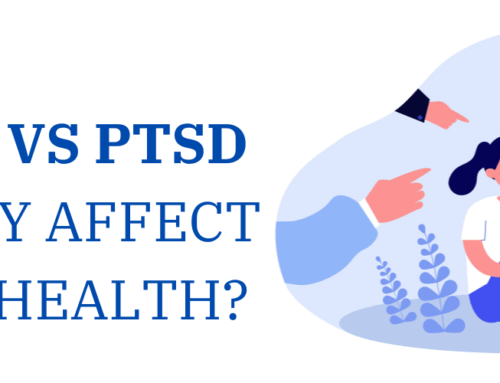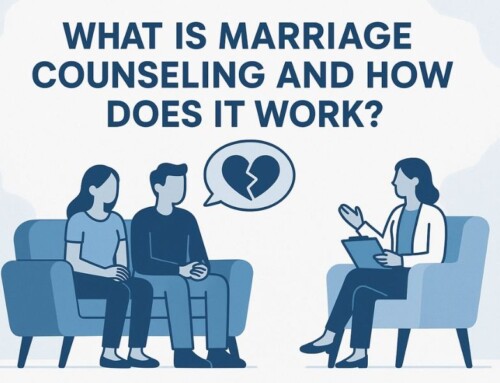What Is Structural Family Therapy?
TL;DR
|
|---|
Families are the first and most influential system we belong to. When that system weakens, unresolved conflict, emotional strain, and communication breakdowns can quickly become the norm.
What is structural family therapy? It’s a clinically proven approach that goes beyond talking about problems. Instead, it restructures how families interact in real time, addressing root causes rather than symptoms.
Unlike traditional counseling, structural family therapy techniques, such as boundary setting, role realignment, and live interaction analysis, are designed to reorganize the family system for lasting change.
Research from the American Association for Marriage and Family Therapy (AAMFT) shows that 90% of clients report improved emotional health and 66% experience better physical health after family therapy.
What is Family Structure Therapy?
Developed by Salvador Minuchin in the 1960s, it’s a therapeutic model that restructures how families connect and function. By reorganizing relationships, setting healthy boundaries, and balancing power dynamics, it addresses the root of recurring family issues.
Using structural family counseling techniques like enactments and boundary setting, therapists work directly with the family’s real‑time interactions to create lasting change. This approach is especially valuable because it targets underlying patterns, not just short‑term problems, helping families build trust, improve communication, and strengthen emotional bonds.
Sometimes, the way forward isn’t about starting over; it’s about reshaping what’s already there. We help families rediscover the strength in their connections.
(Let’s begin that conversation)
How Family Structure Shapes Relationship Health?
In what is structural family therapy, understanding family structure is key to breaking repetitive cycles of conflict. Every family operates through interconnected subsystems, parental, marital, sibling, and extended family units, each with its own rules, roles, and expectations.
Boundaries play a critical role in maintaining and nurturing relationships:
- Rigid boundaries can lead to emotional disconnection, where members feel isolated or unsupported.
- Diffuse boundaries create over‑involvement, blurring roles, and limiting individual autonomy.
According to family systems theory, dysfunctional families frequently display enmeshment or boundary confusion, which are consistently linked to higher conflict and dysfunction. This highlights why unresolved tension often feels like “history repeating itself.”
By applying structural family therapy techniques, therapists can help families identify these boundary patterns and reshape them into healthier, more functional dynamics. Recognizing structure is the first step toward understanding why conflicts keep happening and how to change them for good.
Healthy change isn’t about starting over; it’s about realigning what already exists, and the right relationship counseling can help your family make that shift.
What are the Core Components of Structural Family Therapy?
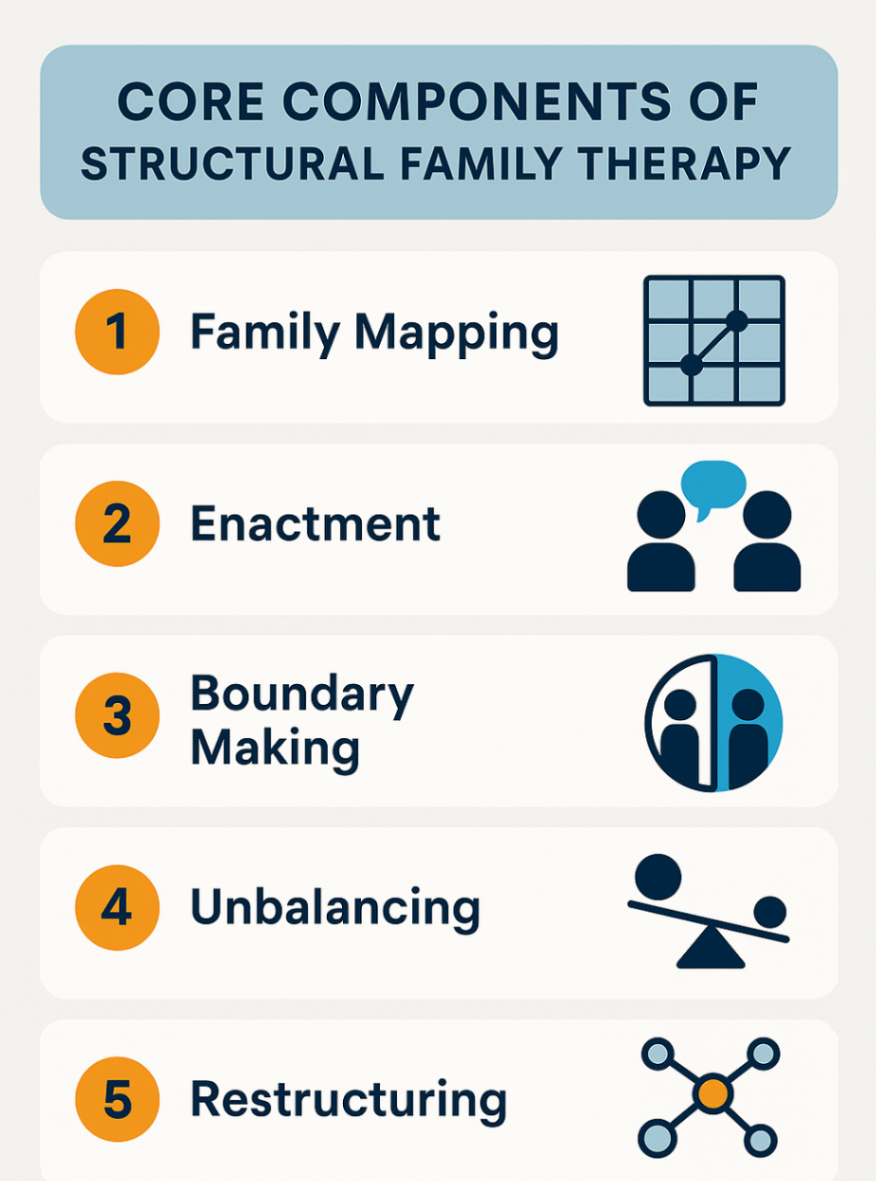
In structural family therapy, the therapist doesn’t just talk about problems; they reshape the family’s structure in real time. These structural family therapy techniques are designed to expose the hidden patterns that keep families stuck and guide them toward healthier ways of connecting.
1. Family Mapping: Making the Invisible Visible
One of the most recognized structural family therapy concepts, family mapping is a visual chart that outlines relationships, alliances, and boundaries. It helps the therapist and the family see where imbalances exist, such as a child taking on parental responsibilities or two members forming an unhealthy alliance. This process is sometimes referred to as structural family therapy mapping, and it’s a foundational diagnostic tool.
2. Enactment: Bringing Patterns into the Room
Instead of relying solely on past stories, the therapist invites family members to role‑play recurring situations. These enactments let the therapist observe real‑time interaction patterns, such as interruptions, dismissive tones, or avoidance behaviors. This active method allows dysfunctional dynamics to surface naturally, making them easier to address.
3. Boundary Making: Adjusting Closeness and Distance
Boundaries are either too rigid, leading to emotional disconnection, or too diffuse, causing enmeshment and loss of autonomy. The therapist helps adjust these boundaries so each family member has healthy space while still feeling connected.
4. Unbalancing: Shifting Stuck Power Dynamics
In some families, power becomes uneven, either children dominate parents, or one parent dominates the family unit. Unbalancing means the therapist temporarily aligns with a less dominant member to challenge entrenched hierarchies and create room for change.
5. Restructuring: Designing Healthier Interaction Patterns
Restructuring is where structural family therapy goals truly come to life. The therapist helps members practice new communication methods, decision‑making styles, and emotional expressions that encourage respect, empathy, and balance.
These interventions work together to transform relationships. Healthy families aren’t free of conflict; they are skilled at navigating it in a way that strengthens bonds rather than breaks them.
What are the Proven SFT Techniques That Create Change?
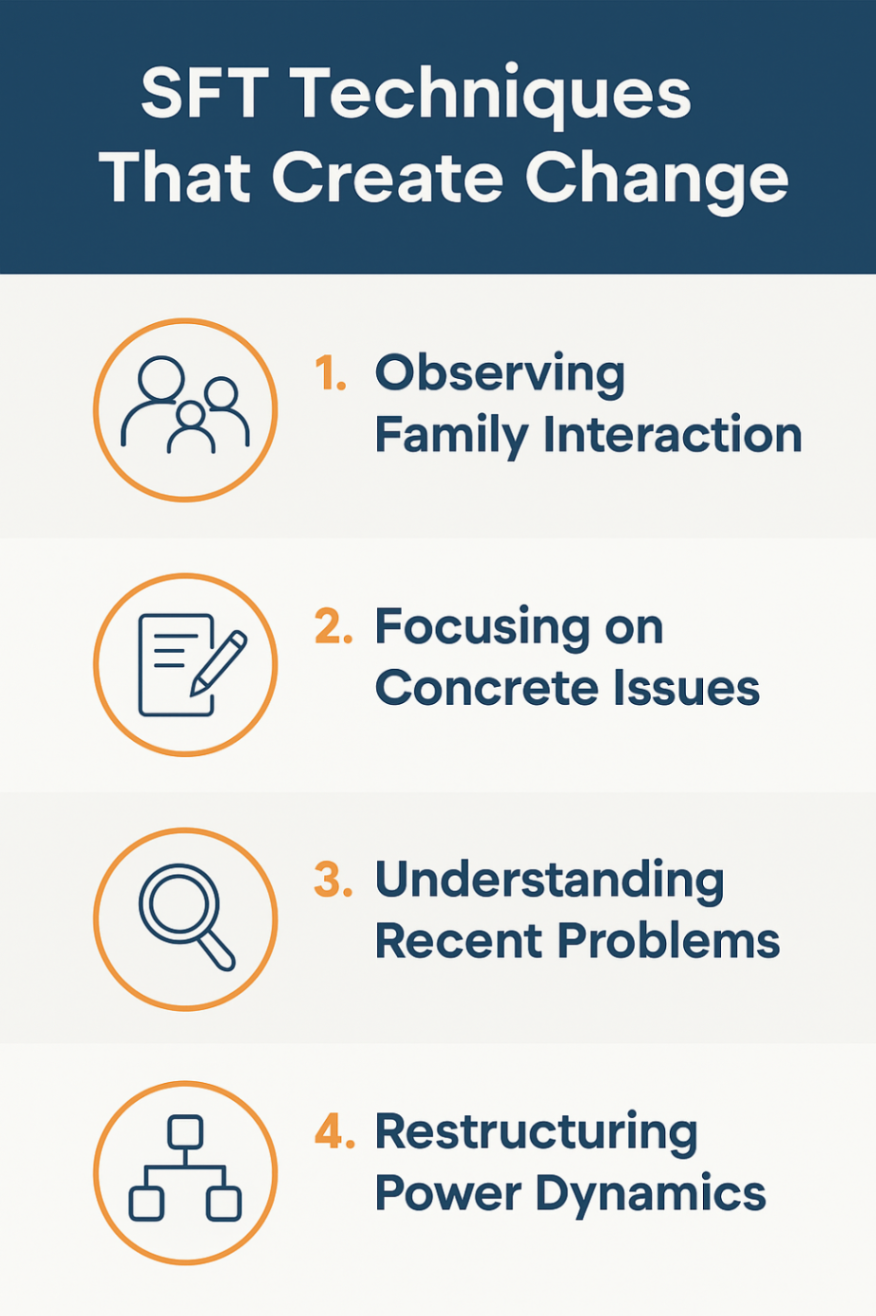
While every family is unique, certain core methods consistently drive progress in structural family therapy. These approaches focus on real-life moments, not just theoretical discussions, to achieve lasting results.
1. Observing Family Interaction
The therapist carefully observes family members in session, tracking verbal cues, tone, body language, and emotional responses. This helps identify triggers, escalation points, and long‑standing interaction loops that fuel conflict.
2. Focusing on Concrete Issues
Abstract discussions can feel safe, but rarely create change. SFT grounds therapy in real-life problems, like arguments about curfew, disagreements on parenting, or recurring financial disputes, so the work feels relevant and actionable.
3. Understanding Recent Problems
Conflicts don’t appear out of nowhere; they emerge from the deeper structure of family roles, boundaries, and expectations. The therapist helps families connect today’s disagreements to these underlying patterns, which is key to breaking the cycle.
4. Restructuring Power Dynamics
A central structural family therapy goal is to ensure no one role dominates or collapses. For example, if a child acts as the family’s peacemaker at the expense of their own needs, the therapist works to restore the parents’ leadership role.
When considering structural vs strategic family therapy, the difference is clear: SFT reshapes relationship patterns in the session itself, rather than relying solely on homework assignments or external tasks. A structural family therapy example might be a therapist guiding parents through setting firm but respectful boundaries during a live enactment.
What are the Measurable Benefits of Structural Family Therapy?
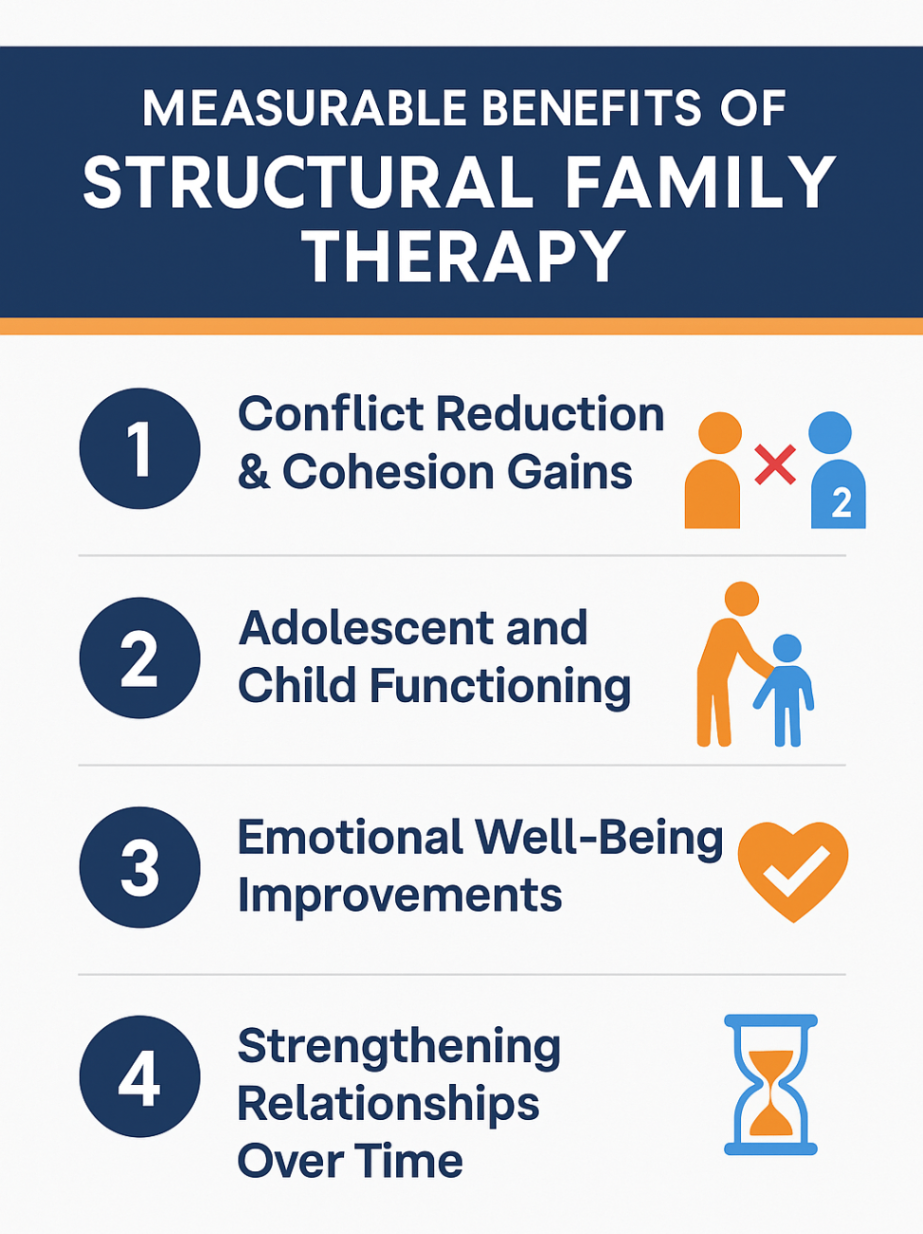
Structural Family Therapy (SFT) offers significant, evidence-supported benefits for families, particularly because it addresses underlying family dynamics rather than just surface symptoms.
1. Conflict Reduction & Cohesion Gains
Research comparing Structural Family Therapy with other family therapy models found that SFT significantly improves family cohesion and adaptability, outperforming methods like mindfulness-based family therapy in clinical trials.
2. Adolescent and Child Functioning
Although direct meta-analyses on adolescent behavior specifically in SFT are limited, studies have shown that family-based systemic interventions significantly reduce behavioral and emotional problems in youth (for instance, in psychosomatic conditions such as anorexia, asthma, and diabetes).
3. Emotional Well‑Being Improvements
SFT’s focus on real‑time family restructuring and clear boundaries is associated with reductions in emotional distress and improved functioning, especially when viewed through broader family system intervention studies..
4. Strengthening Relationships Over Time
Clinical comparisons have shown that SFT produces greater improvements in couple cohesion and adaptability than alternative models, suggesting stronger long‑term relationship resilience.
What are the Common Issues Successfully Addressed with Structural Family Therapy?
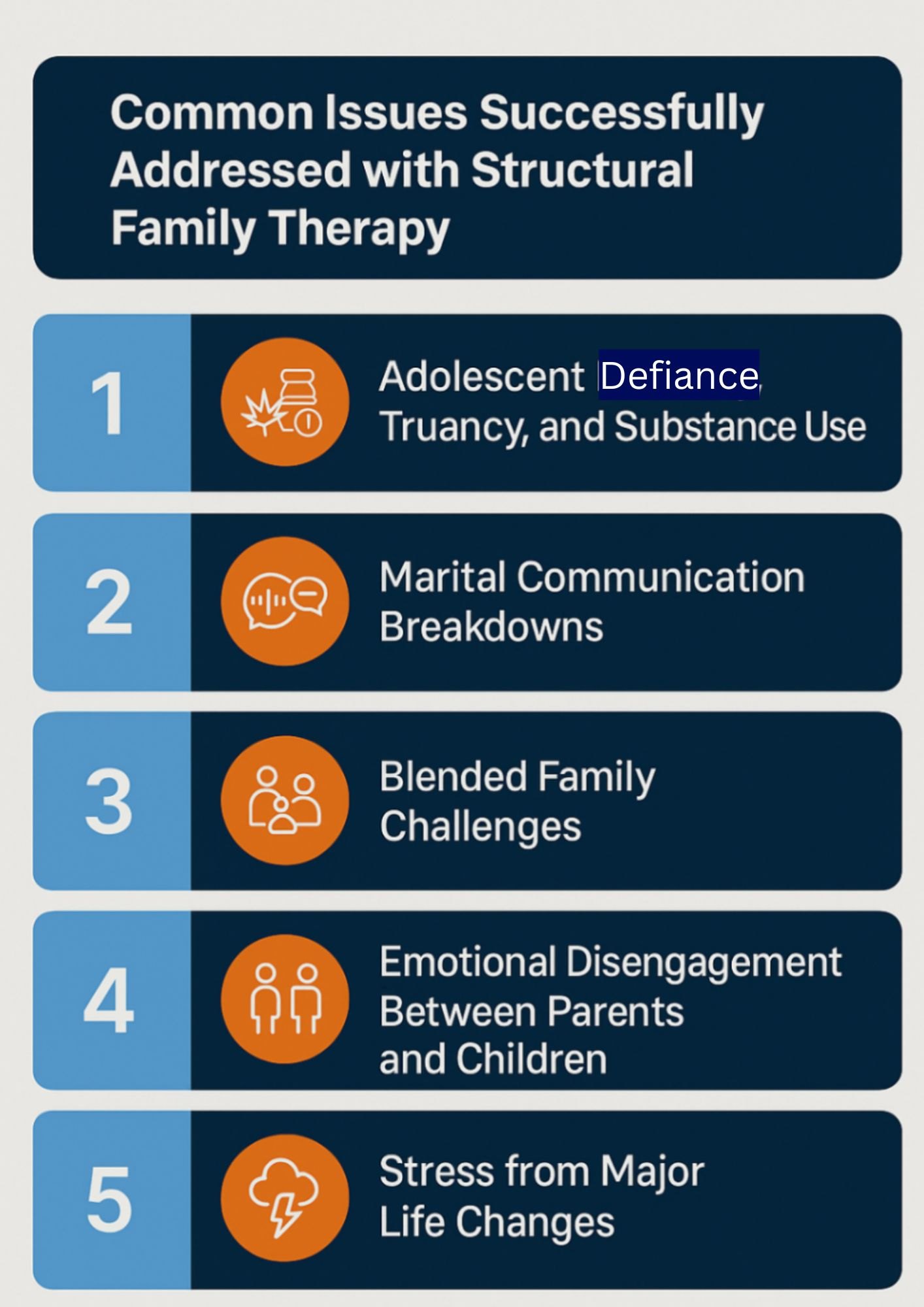
Structural Family Therapy (SFT) is designed to address the root causes of family distress, rather than simply treating the symptoms. By reshaping relationship patterns and clarifying boundaries, SFT helps families navigate some of the most difficult challenges they face.
1. Adolescent Defiance, Truancy, and Substance Use
Teens often express emotional pain through defiance, school refusal, or risky behavior like substance use. SFT helps by strengthening parental leadership, clarifying roles, and creating consistent boundaries that encourage accountability without alienation. Families learn to replace power struggles with open dialogue, so adolescents feel understood rather than controlled.
2. Marital Communication Breakdowns
When partners struggle to express needs without triggering conflict, communication stalls, and resentment grows. SFT works to restore respectful, empathetic exchanges between partners, ensuring each feels heard and valued. This shift not only improves the couple’s relationship but also sets a healthier example for children.
3. Blended Family Challenges
In blended families, loyalty conflicts, unclear roles, and differing parenting styles can cause deep fractures. SFT focuses on creating a unified family structure where each member understands their place, boundaries are respected, and trust can grow naturally over time. This clarity helps reduce rivalry and strengthen connections.
4. Emotional Disengagement Between Parents and Children
Emotional distance can silently weaken family bonds, leaving children feeling unsupported and parents feeling shut out. Through SFT, families learn to reconnect in ways that feel safe and affirming. Therapists guide parents toward consistent emotional availability, helping children feel truly seen and valued.
5. Stress from Major Life Changes
Events like divorce, relocation, job loss, or bereavement can shake a family’s stability. SFT offers tools to navigate these transitions together rather than drifting apart. By reestablishing structure and clear communication, families can process change in a way that fosters resilience and mutual support.
Healthy families aren’t free from challenges; they’re skilled at working through them together. If you’re navigating one of these struggles, it may be time to explore what structured family therapy could mean for your home. Let’s talk about your next step.
When Your Family Feels Stuck, You Don’t Have to Untangle It Alone
Sometimes, it’s not just one argument, one phase, or one mistake; it’s a pattern that keeps circling back. The late‑night silences. The tension you can feel even when no one’s speaking. The feeling that no matter how hard you try, you’re all living in the same house but on different islands.
At Total Life Counseling, we understand that those moments don’t just “pass” on their own. They leave quiet cracks in relationships that can deepen over time. That’s why our therapists don’t just listen; we work with you to reshape the way your family connects.
At our Tampa location, Licensed Mental Health Counselor Gemima McMahon specializes in helping women, couples, children, and teens navigate conflict, strengthen communication, and restore emotional connection. Using Structural Family Therapy alongside other evidence-based approaches, she works with families to break destructive cycles, set healthier boundaries, and rebuild trust that lasts.
You’ve already carried this weight long enough. You don’t have to figure it out by yourself, and you’re not “overreacting” for wanting more harmony at home.
Let’s take the next step together and start turning connection from a hope into a reality.
Conclusion
Structural Family Therapy, developed by psychotherapist Salvador Minuchin, is a powerful form of systemic family therapy that reorganizes the structure of the family to promote harmony and resilience. By addressing the hierarchy of power, setting healthy boundaries, and reframing unhelpful patterns, it strengthens connections among all members of a family.
This approach plays an important role in helping caregivers, parents, and children resolve the family’s problems in a safe, confidential space. Whether addressing gender differences, relationship breakdowns, or a mental health condition, SFT empowers the entire family system to function in healthier, more supportive, and lasting ways.
Frequently Asked Questions
Who can benefit from Structural Family Therapy?
Structural family therapy is a good type of therapy for members of the family who have problems or dysfunction. Vulnerable families, adults, and children who have mental health issues can often get help from family therapy like this. Family therapists work on fixing things inside the family system to help everyone be stronger and heal.
How long does Structural Family Therapy typically take?
The time that you spend in structural family therapy can depend on the type of therapy and what each family needs. Most structural family therapists will suggest a treatment plan that can last for a few weeks or even a few months. This is because family dynamics can be complex, and it may take time to work on them. With each session, families start to change the way they talk and act with each other. Structural family therapy works over time to help everyone adjust and get better.
Is Structural Family Therapy effective for adolescents?
SFT works well for young adults and teens who have mental health problems. It helps by looking at problems that come up in the family structure. The therapy brings people closer, so the family becomes more supportive. This can help with recovery from mental health issues and make family dynamics better for all.
What issues are commonly addressed with this approach?
SFT is often used to help with substance abuse, dysfunction, family problems, and bad relationships. Family therapists work with people in the family to fix boundaries. They also try to lower stress in the home. This can help bring the family closer and strengthen their relationships. The way everyone interacts in the family can get better with SFT.
How do I find a qualified Structural Family Therapist in the US?
Finding good help in therapy is very important. You need to look for licensed structural family therapists through the American Psychological Association or often on therapy websites. For example, there are family therapists in New York who can help you look at treatment options that are right for your family’s needs and ensure their competence.
Filed in: Family Therapy, Gemima McMahon
Share This Story, Choose Your Platform!
Total Life Counseling Center consists of Licensed Counselors, masters level therapists, Español counselors, Licensed Mental Health Counselors, business coaches, and image enhancement coaches who provide counseling for emotional, mental, physical and spiritual care including marriage, individual, family, substance abuse and more. TLC’s family, trauma and marriage experts have been interviewed on National and Local TV/Radio over 200 times for their expert advice on Fox News, OWN, WETV, ABC’s Medical Minute and more. Our skilled counselors are relational, approachable and specialists providing therapy services in the Central Florida area including: Orlando, Winter Park, MetroWest, Windermere, Dr. Phillips, East Orlando, Lake Mary, and Clermont, Boca Raton Florida, and Dallas, TX.





